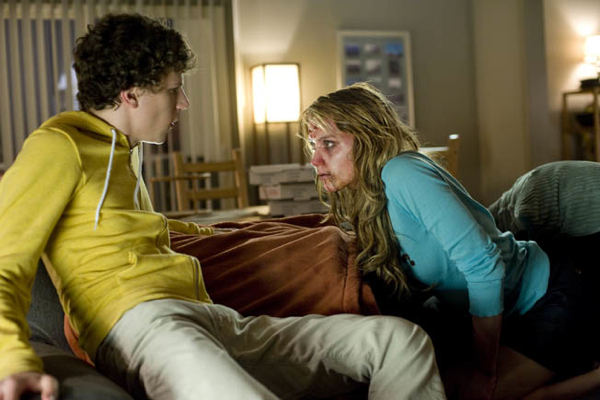Movie review by Greg Carlson
WARNING: The following review discusses the identity of an actor who makes an unexpected appearance in “Zombieland.” Do not read the article if you plan to attend the movie and would like to preserve the surprise.
Neophyte feature director Ruben Fleischer delivers one of the most breathless and entertaining movies of the year in “Zombieland,” a video game-like road trip through a gruesomely funny carnival of rainbow colored, post-apocalyptic mayhem and survivalism. Blasting through some genre conventions while honoring sacrosanct linchpins, Fleischer’s approach most closely parallels Edgar Wright and Simon Pegg’s witty “Shaun of the Dead,” the gold standard of zombie comedy. The self-consciously stylish “Zombieland” is fueled by Rhett Reese and Paul Wernick’s nimble script, hewing closer to the lighthearted quips of the “Evil Dead” series than the gallows humor of George Romero’s “Night of the Living Dead” sequels.
The action of “Zombieland” picks up with society already in chaotic freefall. A devilishly creative credit sequence set to Metallica’s “For Whom the Bell Tolls” presents a gallery of dread in gorgeously silky slow motion, introducing the basic rules that have facilitated IBS-suffering protagonist Columbus’ (Jesse Eisenberg) vitality in a world overrun by flesh-eating ghouls. The wry criteria, which continue to pop up on the screen throughout the duration of the movie, include obvious fundamentals like “check the backseat” and “beware of bathrooms,” as well as sound advice on the value of seatbelts and the necessity of the double tap when verifying a zombie’s incapacitation.
Columbus joins forces with seasoned zombie killer Tallahassee (Woody Harrelson) and shortly thereafter the men cross paths with tricky sisters Wichita (Emma Stone) and Little Rock (Abigail Breslin), who are headed toward a supposedly zombie-free amusement park. The mismatched quartet bicker like the Griswolds en route to Walley World, and the filmmakers simultaneously mock and embrace the transformation of the ragtag crew into a functioning family unit. Harrelson’s mugging, scene-stealing performance challenges the other actors, but Eisenberg, Stone and Breslin manage to hold their own. The movie stumbles a little when resorting to a predictable girls-in-peril complication in the plotting, but most of the action is smartly engineered.
One of the most memorable sequences in “Zombieland” detours the foursome to the opulent mansion of Bill Murray, playing a droll version of himself in a clinic of self-parody on par with John Malkovich in “Being John Malkovich.” Murray, who has disguised himself as a rotting corpse to blend in with the creatures that would otherwise devour him, gamely hosts the desperate interlopers. The actor gracefully accepts the fawning praise of his star-struck guests, and participates in the recreation of a scene from “Ghostbusters.” Like a similar take-off in “Be Kind Rewind,” the “sweded” bit of Ivan Reitman’s comic colossus reminds viewers of the collective fun of going to the movies.
Additionally, the funfair setting for the movie’s climactic showdown, in which zombies are inventively dispatched with the help of repurposed rides and games, echoes the guilt-free saturnalia that is a crucial byproduct of zombie cinema: the opportunity for audiences to cheer the vicarious physical pleasures of seeing woeful meat puppets slaughtered in large numbers. Far from being antisocial, viewer gratification in witnessing the misfortunes of the screen undead allows the concurrent recognition and denial of one’s own death. “Zombieland” can certainly be enjoyed without the need of a psychoanalytic reading, but it is rich enough to accommodate multiple interpretations.
